When you're traveling with medications like insulin, vaccines, or biologics, the weather outside can be just as dangerous as the road itself. A hot car seat or a freezing airport tarmac can ruin your medicine before you even get to your destination. You don't need a PhD in pharmacology to keep your drugs safe - you just need to know what to do, when, and why.
Know Your Medication's Temperature Needs
Not all medications are the same. Some can handle room temperature. Others will break down in minutes if they get too hot or too cold. The three main categories you need to know are:- Ambient (15°C-25°C): Most pills, capsules, and some liquids. These are the easiest to transport. Just keep them out of direct sunlight and don’t leave them in a hot car.
- Refrigerated (2°C-8°C): Insulin, many vaccines, biologics, and some antibiotics. These are the most fragile. If they freeze or overheat, they lose effectiveness - sometimes permanently.
- Cryogenic (below -150°C): Rare for personal use. Mostly for specialized treatments like certain cancer therapies or tissue samples. Most travelers won’t need this, but if you do, you’re already working with a medical team that handles it for you.
Check the label. If it says "store in the refrigerator," assume it’s sensitive. If it says "keep at room temperature," avoid heat above 30°C. Don’t guess. Your life could depend on it.
Hot Weather: Don’t Let Your Medicine Cook
Summer heat is brutal on medication. In Perth, where temperatures regularly hit 40°C in January, a car interior can hit 60°C in under an hour. That’s enough to ruin insulin in 30 minutes.Here’s what works:
- Never leave meds in the car. Even in the shade. A 2023 study found that 68% of pharmacy-reported temperature excursions happened because packages were left outside delivery doors or in parked cars.
- Use an insulated cooler bag. A standard lunch bag with two frozen gel packs can keep insulin at 2°C-8°C for up to 8 hours in 35°C weather. You don’t need fancy gear.
- Carry it with you. Keep your meds in your purse, backpack, or a pocket. Body heat is your friend in hot weather - it’s better than a sweltering trunk.
- Avoid direct sunlight. Even if it’s cool, UV rays can degrade some medications. Wrap them in a towel or keep them in a dark compartment.
- Don’t use ice cubes. They can freeze your medicine. Use gel packs instead. They stay cold longer and won’t leak.
Insulin is the most common casualty. If it looks cloudy, clumpy, or has particles in it, throw it out. No exceptions. Your pharmacist can confirm if it’s still safe - but don’t wait until you’re in a remote area.
Cold Weather: Beware the Freeze
Cold is just as dangerous as heat - but people don’t think about it. If your medicine freezes, the structure of proteins and active ingredients can break down. That’s true for insulin, epinephrine auto-injectors, and many vaccines.Winter travel tips:
- Keep meds close to your body. Tuck your insulin pen into your inner jacket pocket. Your body heat keeps it safe.
- Avoid checked luggage. Airplane cargo holds can drop below -20°C. Even if the plane is warm inside, the baggage area isn’t. Always carry your meds on board.
- Use insulated packaging. Even a simple foam cooler with a warm water bottle wrapped in a towel can buffer against extreme cold. Don’t let your meds sit on a cold floor or in a freezing car overnight.
- Don’t use hand warmers directly on the container. They can overheat or create hot spots. Place them beside, not on top of, your medication.
- Plan for delays. If your flight is grounded in a cold airport, don’t leave your bag unattended. Ask the gate agent if you can keep it in the cabin.
A 2022 logistics report showed that 17% more temperature excursions occurred below range during winter than above - mostly because people didn’t realize cold could be a problem.
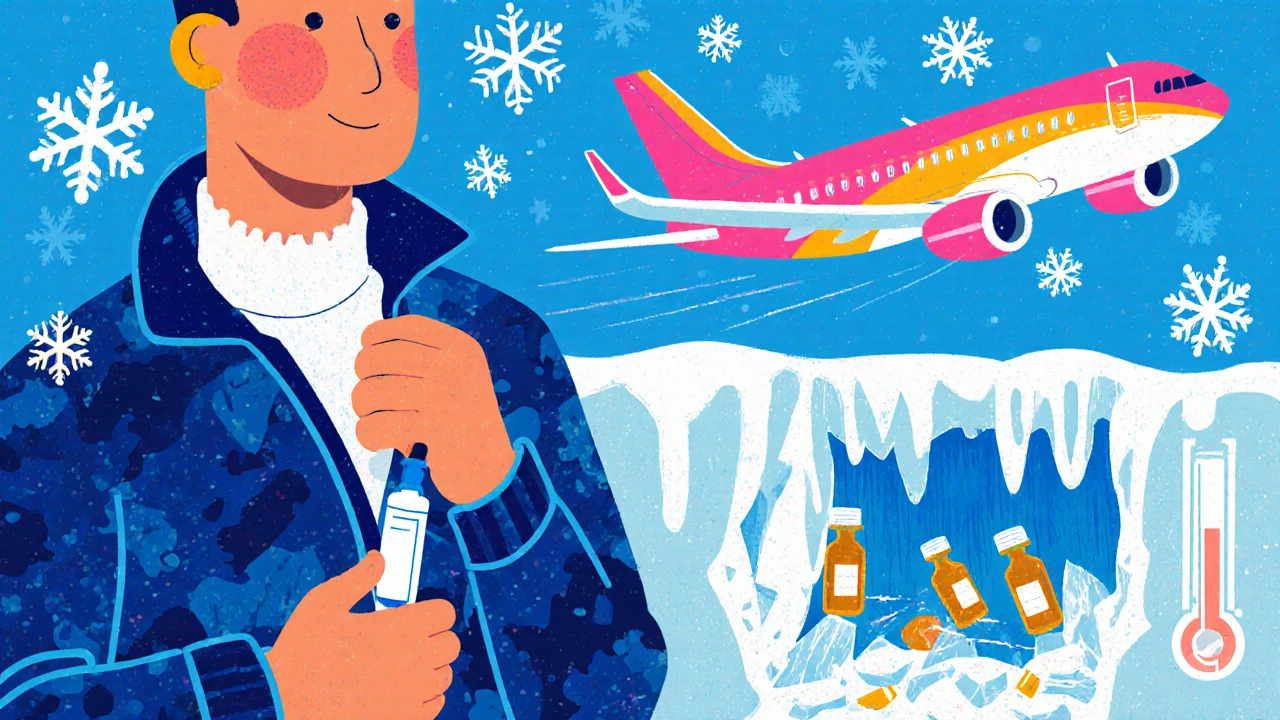
Traveling by Air: What Airlines Won’t Tell You
Airlines don’t guarantee temperature control in cargo holds. Period. Even if you check your bag as "perishable," it’s still going into a space that can get colder than your freezer.Do this instead:
- Carry everything on. TSA allows medical supplies through security. You don’t need a doctor’s note, but having a prescription label on the bottle helps.
- Use a travel cooler. Products like the TempAid 2.0 keep insulin cold for 48 hours and are approved for air travel. They weigh about 1.5 kg - heavy, but worth it.
- Ask for a temperature-controlled storage bin. Some airports have them. Call ahead. Mention you’re carrying temperature-sensitive medication. They’re often happy to help.
- Don’t trust the overhead bin. It’s not climate-controlled. If you’re on a long flight, ask a flight attendant if you can store your bag near the galley - where it’s slightly warmer.
Real story: A traveler in Sydney left her insulin in checked luggage during a 10-hour layover in Melbourne. The cargo hold hit -18°C. The insulin froze. She had to buy a new pen at the airport - at $300 a pop.
What Works: Packaging Solutions Compared
You don’t need to spend hundreds. Here’s a simple breakdown:| Method | Temp Range Maintained | Duration | Cost | Best For |
|---|---|---|---|---|
| Insulated lunch bag + 2 gel packs | 2°C-8°C | 6-8 hours | $10-$20 | Day trips, short flights |
| TempAid 2.0 or similar travel cooler | 2°C-8°C | 48 hours | $120-$180 | Long trips, international travel |
| Passive insulated box (pharmacy-grade) | 15°C-25°C or 2°C-8°C | 24-72 hours | $30-$80 | Mail-order meds, local delivery |
| Active refrigerated carrier (powered) | Custom, precise | Indefinite | $500-$1,200 | Medical professionals, long-term transport |
For most people, the lunch bag trick is enough. It’s simple, cheap, and proven. For frequent travelers or those with life-sustaining meds, the TempAid-style cooler is worth the investment.
The Last Mile Is the Most Dangerous
Here’s the truth no one talks about: most temperature failures don’t happen during transit. They happen at the end.When you arrive at your hotel, do you leave your meds on the counter while you unpack? Do you leave your insulin in the car while you check in? Do you let your package sit on the porch until you get home?
That’s where 43% of all excursions happen - according to Sensitech’s 2023 data. The moment you stop moving, you become vulnerable.
Fix it:
- Go straight to your room. Don’t delay.
- Put your meds in the fridge or cooler immediately.
- If you’re using a delivery service, arrange to be home when it arrives.
- If you can’t be there, ask a neighbor or front desk to store it properly.
It’s not about being paranoid. It’s about being smart.
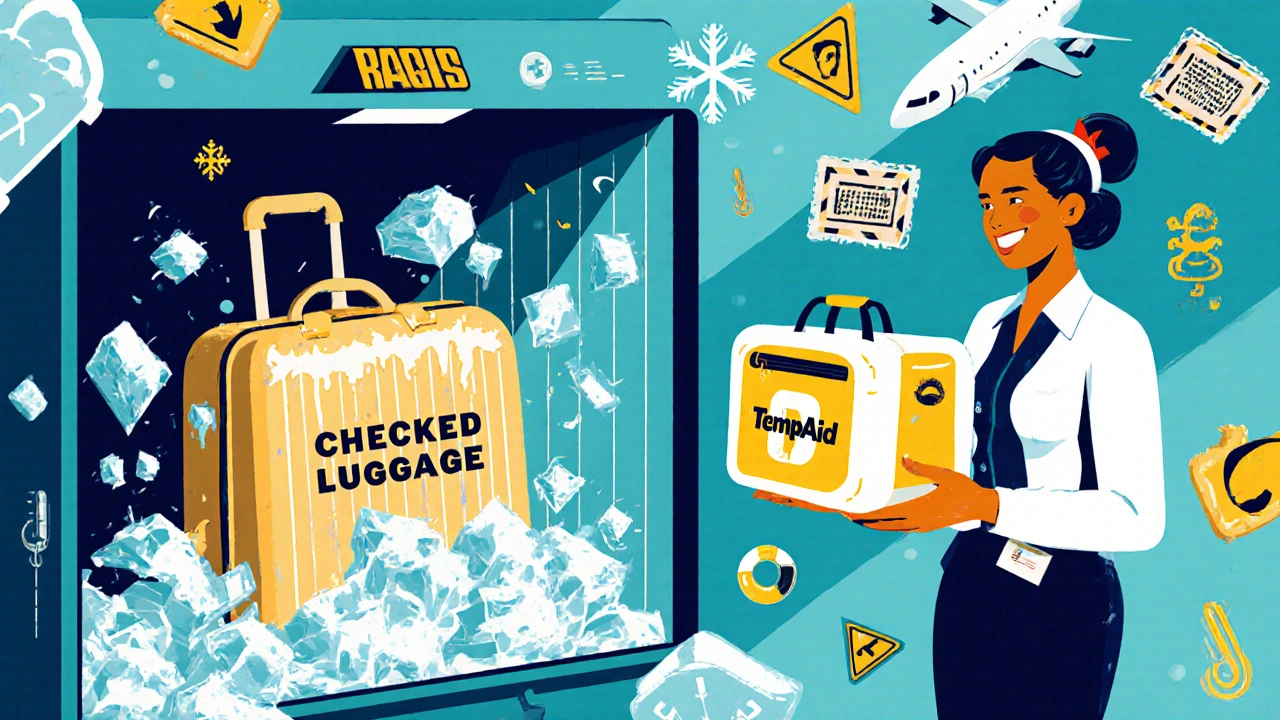
Documentation and Backup
Always carry a copy of your prescription. Not just a photo - a printed copy. Some countries require it. Even if you don’t think you’ll need it, you might.Also, bring extra medication. At least a 3-day supply beyond your trip. Store it separately - in a different bag, with a different person if you’re traveling with someone.
If you’re flying internationally, check the destination country’s rules. Some ban certain insulin brands or require special permits. Don’t assume your meds are legal everywhere.
What to Do If Your Medicine Gets Too Hot or Cold
If you suspect your medication was exposed to extreme temperatures:- Don’t use it. Even if it looks fine.
- Check for changes. Cloudy insulin? Discolored liquid? Strange smell? Toss it.
- Contact your pharmacy. They can tell you if it’s still safe based on the drug and exposure time.
- Call your doctor. They may be able to get you a replacement quickly.
- Document it. Note the time, temperature, and what happened. This matters if you need insurance or manufacturer support later.
There’s no such thing as "it’s probably still okay." If the temperature was outside the range, assume it’s damaged.
Final Rule: When in Doubt, Replace It
Medications aren’t like food. You can’t taste them to see if they’re bad. You can’t smell them. You can’t see the damage until it’s too late.It’s cheaper to replace a $50 insulin pen than to risk a diabetic emergency. It’s cheaper to buy a new vaccine than to get sick because it didn’t work.
Always have a backup plan. Know where the nearest pharmacy is. Save your doctor’s number. Carry a list of your meds and dosages.
Temperature control isn’t complicated. It’s just inconvenient. And that’s why people skip it. But when you’re responsible for your own health - or someone else’s - inconvenience is the price of safety.
Don’t wait for a crisis to learn this lesson. Plan ahead. Pack smart. Keep your meds with you. And never, ever trust a car, a baggage claim, or a porch to protect what keeps you alive.
Can I put my insulin in the airplane’s fridge?
No. Airlines don’t provide refrigerated storage for passenger medications. Even if you ask, they won’t do it. Always carry your insulin with you in a travel cooler. The overhead bin and cargo hold are not safe.
Is it okay to leave medication in a cold car overnight?
No. Temperatures below 0°C can freeze insulin, epinephrine, and other biologics, permanently damaging them. Even if the car feels cold but not freezing, it’s still risky. Always bring your meds inside with you.
What’s the best way to carry medications through airport security?
Place your medications in a clear plastic bag and declare them to the TSA officer. You don’t need a doctor’s note, but having the original prescription label on the bottle helps speed things up. Keep them in your carry-on - never checked luggage.
Can I use regular ice packs to keep my meds cold?
No. Regular ice can freeze your medication. Use gel packs designed for medical transport - they stay cold longer and won’t drop below 0°C. If you must use ice, wrap it in a towel and keep it separate from your meds.
What should I do if my medication gets exposed to extreme heat?
Stop using it immediately. Look for changes in color, texture, or smell. Call your pharmacist or doctor. Most manufacturers will replace damaged medication if you report the issue with details. Never risk injecting or taking degraded medicine.
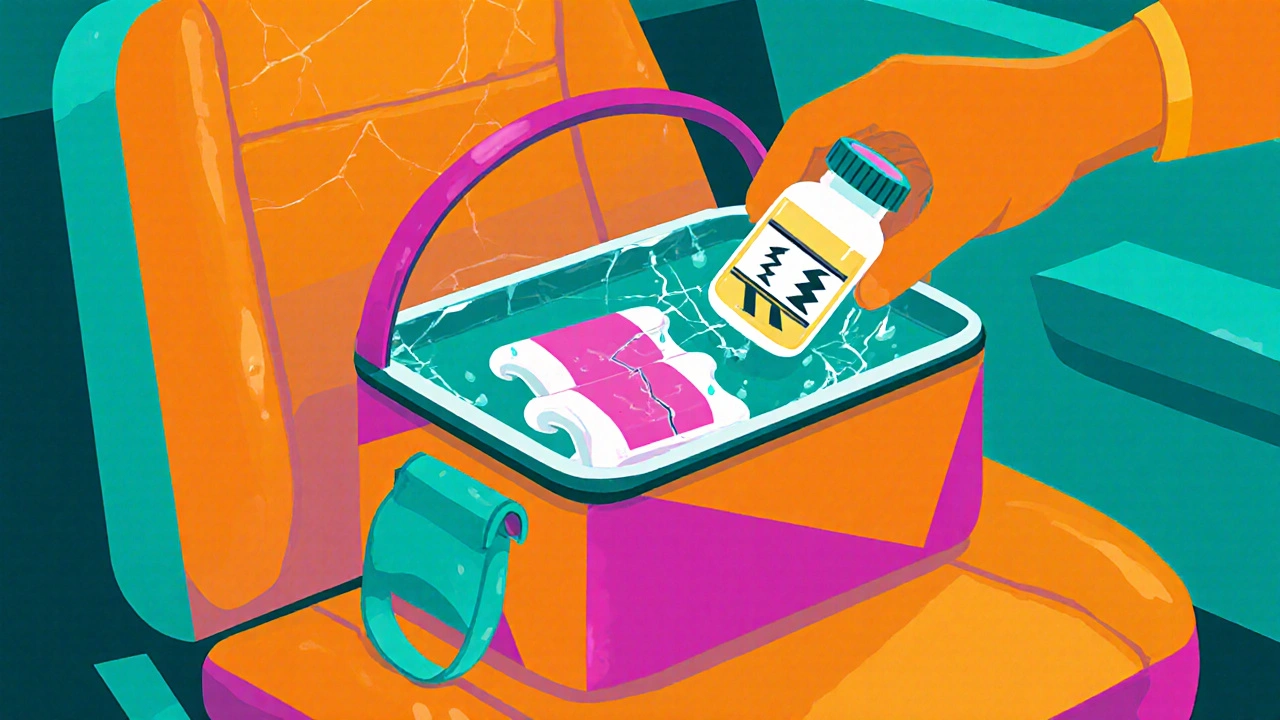

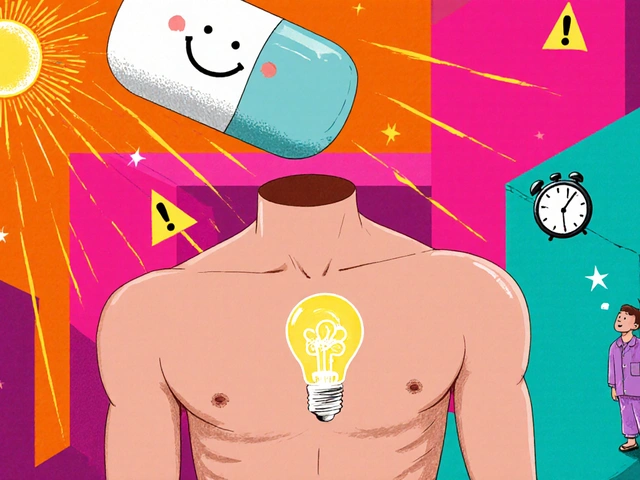


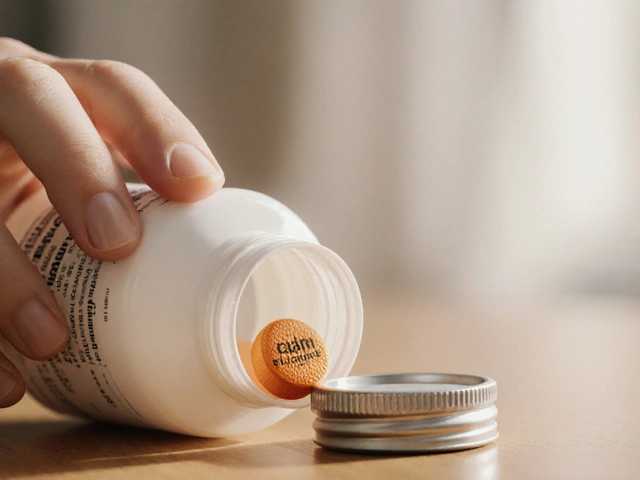
Kane Ren
November 22, 2025 AT 07:13Just saved this for my trip to Alaska next month - insulin in my jacket pocket, gel packs in my carry-on, and zero trust in checked luggage. Simple, but life-saving.
Dalton Adams
November 22, 2025 AT 19:16Actually, most people don’t realize that the FDA doesn’t even regulate temperature transport for personal meds - it’s all on you. And no, your ‘insulated lunch bag’ isn’t FDA-approved. If you’re carrying biologics, you’re already in the 0.3% of people who need real solutions - like TempAid or a powered carrier. The rest of you are just lucky.
Also, ‘don’t use ice cubes’? Please. Ice melts at 0°C. Gel packs are designed to stay at 2–8°C. You’re not a scientist, but you should at least read the label.
And yes - I’ve worked in pharma logistics. I’ve seen insulin go bad in cargo holds. It’s not dramatic. It’s just tragic. And preventable. 😒
Charmaine Barcelon
November 24, 2025 AT 06:42You’re all being so careless. I’ve seen people leave their epinephrine in a car for 20 minutes in 90-degree weather. And then they wonder why they had a reaction. It’s not ‘maybe’ dangerous. It’s ALWAYS dangerous. Stop being lazy. Your life isn’t a suggestion.
Pramod Kumar
November 25, 2025 AT 11:49Bro, this hit different. I’m from Chennai, and last monsoon, my insulin got soaked in a downpour while waiting for a rickshaw. I wrapped it in a dry towel, held it under my shirt, and walked 2 km. No fridge. No cooler. Just body heat and prayer. 🙏
Turns out, it worked. The pen was fine. But I learned: your body is the best temperature controller you’ve got. Don’t underestimate it.
Also, if you’re traveling with meds - tell someone. Not just a doctor. A friend. A stranger at the airport. Someone who knows what you’re carrying. Because when you’re out cold or confused, that person might save you.
Brandy Walley
November 27, 2025 AT 09:05why do people overcomplicate this. i just put my insulin in my pocket. done. if it freezes or melts, its not my problem. i dont need a whole article on this. just give me the pill.
shreyas yashas
November 27, 2025 AT 09:40Been doing this for years - insulin in inner coat pocket, gel packs in backpack. Even in the Himalayas, when it hit -5°C, my pen stayed safe. No fancy gear. Just common sense.
Also, never trust a hotel mini-fridge. They cycle temps. I always ask for a cooler box - they usually give it for free if you say it’s for meds.
Suresh Ramaiyan
November 28, 2025 AT 21:15There’s a quiet dignity in taking care of your own medicine. It’s not just about logistics - it’s about honoring the fact that your body trusts you to keep it alive.
Most people treat meds like groceries. But insulin? Epinephrine? These aren’t snacks. They’re lifelines. And the fact that you’re reading this - that you care enough to plan - means you’re already ahead of most.
Don’t let the noise of ‘it’s probably fine’ drown out the truth: you’re responsible. And that’s not a burden. It’s power.
Katy Bell
November 29, 2025 AT 01:54OMG YES. I once left my epinephrine in the car while I ran into a store for snacks. Came back, it was warm. I panicked. Called my endo. She said, ‘Throw it out. Now.’ I did. Bought a new one. Felt like a jerk… but alive. 🥲
So… yeah. Don’t be me.
Linda Rosie
November 30, 2025 AT 08:41Carry-on only. No exceptions.
Vivian C Martinez
December 1, 2025 AT 04:39Just wanted to say thank you for writing this. I’m a type 1 diabetic, and I’ve had insulin go bad twice because I didn’t know. This is the clearest, most practical guide I’ve ever read. I’m sharing it with my entire support group.
Jennifer Shannon
December 3, 2025 AT 04:12You know, I used to think this was overkill - until I went to Japan last year and realized their pharmacies don’t stock the same insulin brands as the U.S. I had to fly with three pens, two gel packs, a printed prescription, and a note from my doctor in three languages. And I still got stopped at customs because they thought my cooler was a ‘cooling device for food.’
So now? I carry a laminated card that says: ‘TEMPERATURE-SENSITIVE MEDICATION - DO NOT FREEZE OR EXPOSE TO HEAT - FOR PERSONAL MEDICAL USE.’ I’ve never had an issue since.
Also, I put a tiny note inside my cooler: ‘This is not a lunchbox. It’s my life.’ It’s weird. But people get it. 😊
And yes - I’ve had flight attendants move my bag to the galley. One even brought me a warm towel to wrap it in. Turns out, kindness is the best insulation.
Don’t underestimate the power of a calm voice and a clear explanation. Most people want to help. They just don’t know how - until you show them.
And if you’re traveling with someone who doesn’t get it? Don’t yell. Don’t judge. Just say: ‘If you ever needed this to live… would you risk it?’
They’ll get it.
Suzan Wanjiru
December 4, 2025 AT 12:13gel packs work better than ice and dont leak. also dont put meds next to the battery in your phone. heat from charging can mess with them too. learned that the hard way.
Kezia Katherine Lewis
December 4, 2025 AT 17:18It’s worth noting that the WHO’s Cold Chain Guidelines for Biologics (2021) classify ambient-stable medications as Category B, while refrigerated biologics fall under Category A - requiring passive or active thermal management during transport. Most consumer-grade insulated bags meet ISO 13485:2016 standards for Class I medical transport devices, but only if the thermal mass is calibrated correctly.
For optimal efficacy, maintain a thermal gradient of ≤2°C/hour during transit. Exceeding this threshold can induce protein denaturation in monoclonal antibodies - even if the core temperature remains within range.
TL;DR: Your lunch bag might work for insulin, but for vaccines or CAR-T therapies, you need validated packaging with temperature loggers. Otherwise, you’re not just risking efficacy - you’re violating biosecurity protocols.
Olanrewaju Jeph
December 5, 2025 AT 05:40This is exactly the kind of practical, no-nonsense advice people need. I’m from Lagos, and in our heat, meds spoil faster than bread. I’ve seen people leave insulin on a bus seat - and then wonder why they got sick.
But here’s what I tell my community: You don’t need money to be smart. A clean cloth, a water bottle, and your body heat? That’s your first line of defense.
And if you’re traveling? Tell someone - a driver, a nurse, a stranger - what you’re carrying. Most people will help if you ask clearly. Don’t be shy. Your life matters more than your pride.
Thank you for writing this. I’m printing it and sharing it at my church, my clinic, my market. Everyone needs to know.
Karla Morales
December 6, 2025 AT 23:29Okay, but let’s be real - the entire system is broken. Why should a diabetic have to carry a $150 cooler just to get to their hotel? Why is this even a thing? We live in 2024. We have smart fridges, drones, AI logistics - but people still die because their insulin froze in a cargo hold?
And yet, the pharmaceutical companies make billions selling these drugs - and don’t provide free, reliable transport solutions.
It’s not about ‘being responsible.’ It’s about systemic neglect. And until we treat life-saving medication like a human right - not a luxury - this will keep happening.
So yes, use your cooler. Carry your meds. But don’t pat yourself on the back for surviving a system designed to fail you.
❤️🩹
Olanrewaju Jeph
December 7, 2025 AT 19:17And to the person who said ‘just put it in your pocket’ - I get it. I’ve done it too. But what if you’re on a 14-hour flight and your pocket gets cold? Or you sweat and the pen slips? Or you’re in a hospital and your bag gets taken? That’s when the system fails you.
This isn’t about being paranoid. It’s about being prepared. And preparation? That’s dignity.